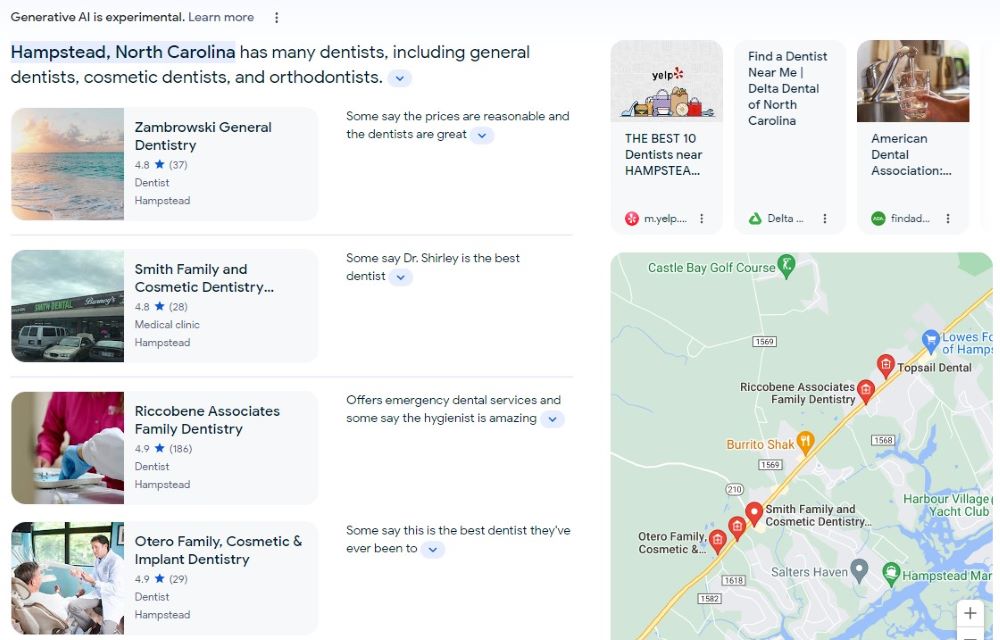SEO Investment

11 Ways to Make Your SEO Investment Work Harder in 2024
Despite the year we’ve had with AI, SEO isn’t going anywhere. If anything, it’s more important now more than ever for businesses to make an SEO investment to gain higher rankings online.
However, simply investing in search engine optimization (SEO) is just the first step. You need to implement the right strategies and tactics to maximize your SEO campaign. You will see a higher return on investment (ROI).
This article highlights 11 essential strategies and new ranking factors your agency must be aware of in 2024.
Highlights
- “Openness” is a Local Map Pack ranking factor. Reflect accurate hours of operation.
- Google SGE ranking factors differ from traditional SEO ranking factors. Test pages individually.
Table of Contents
- Should You Invest in SEO?
- Local SEO Investment: Vital Strategies to Improve ASAP
- Traditional SEO Strategies to Secure Your SEO Investment
Should You Invest in SEO?
Is SEO worth the investment? Yes, SEO is necessary for business websites to improve their online presence and increase their online revenue.
SEO is a long-term strategy that drives ongoing growth for websites, unlike other digital marketing channels that generate short bouts of traffic and leads.
If you’re on the fence about whether to invest in SEO, ask yourself three vital questions that will help determine whether SEO is worth it for your business.
Local SEO Investment: Vital Strategies to Improve ASAP
Local SEO is critical for businesses wanting to dominate their local markets. Help your clients capture more local business by optimizing for these four local SEO strategies immediately.
1. Update and Strengthen Google Business Profiles
Google Business Profile (GBP) plays a crucial role in achieving Local Pack rankings for relevant local keywords. We’ve harped on this before and will continue doing so — YOU MUST SHOW ACCURATE BUSINESS INFORMATION ON YOUR GOOGLE BUSINESS PROFILE.
Google just confirmed that “openness” is a local ranking factor. It’s vital to keep your business hours consistent and accurate to climb up the ranks in the Local Map Packs.
😱Well the news is out, the new ranking factor we are seeing that has a massive impact on ranking is HOURS. We’re seeing that businesses literally vanish in the local pack when they are not open. We started seeing this with the November 2023 core update. This is also making… pic.twitter.com/kDzfrbNmB5
— Joy Hawkins (@JoyanneHawkins) December 7, 2023
While you’re updating your hours, ensure that the rest of your business information is also consistent and accurate:
- NAP (name, address, and phone number)
- Website URL
- Products and services offered
- Pricing
2. Strengthen Local Citations for Better Local Search Rankings
Citations refer to mentions of your business on other websites and directories. Google uses this information to determine how authoritative your business is in your local area. Google Business Profile is just one online directory type; there are many other options to get listed!
The sentiment above holds true here as well. Update all of your local citations in every online directory your client’s business is listed in. Inconsistencies lead to distrust and reduced online rankings, which means reduced traffic and sales.
Additionally, make sure that you’re listing your clients in the most relevant online directories for their businesses.
3. Acquire More Positive (and Honest) Online Reviews
Online reviews are a ranking factor for the Local Map Pack on Google. The higher the number of positive, authentic online reviews a business earns, the higher they show up on the Local Map Pack.
If review generation is something your marketing agency can’t dedicate time to, white label SEO services are there to help! Offload this responsibility to your white label partner while you focus on managing client relationships.
Pro Tip: Businesses are susceptible to fake reviews. It’s unfair, and there’s nothing to stop bots or people from leaving fake reviews, but there’s good news — you can flag and remove them!
Learn how to spot and remove fake reviews on Google Business Profile.
4. Optimize for SGE (Google’s Search Generative Experience)
SGE is Google’s AI Search Generative Experience. The ranking factors for SGE are different from traditional SEO.

While the optimization strategies aren’t entirely clear for SGE, findings show that sitewide optimizations are unnecessary to rank in Google’s SGE. Page-by-page optimizations are enough for now.
We recommend running tests on the most important pages you want to rank in SGE. Document everything thoroughly and monitor what results you see. Keep close tabs on the competitors that do rank in Google’s SGE for your primary keywords. Run an in-depth analysis of their pages. Compare this to your own and note every difference.
Traditional SEO Strategies to Secure Your SEO Investment
5. Keywords Must Match User Search Intent
Your website content needs to match the user’s search intent. Only focusing on search volume rather than user intent will hurt your clients’ abilities to rank for relevant target terms.
If you have Semrush (a favorite SEO tool our ours), an easy way to check the search intent for keywords is using the “Keyword Overview” tool. Enter a keyword into the search bar above, and the SERP results will appear towards the middle of the page. It will show you the organic search results for positions 1 – 100.
6. Answer All Possible Questions in the Content
When creating content for your website, be sure to answer all possible questions that users might have. Giving your target audience all the information they’re looking for on your website will reduce their chances of leaving your website for another source.
It also signals to search engines that your website is an authority in your industry or niche. Around this time last year, Google revised their Search Quality Raters Guidelines to “E-E-A-T” instead of “E-A-T.”
The extra “E” stands for “Experience.” Google will consider the company’s experience on a topic or industry when determining the SERP results. Be thorough in your content creation by addressing all possible questions and delivering your website visitors the best possible user experience.
Clearly convey your client’s topical authority on the subject by showcasing their experience, highlighting successful case studies, and more. See full details on how to optimize websites for Google E-E-A-T here!
7. Create Content Targeting Full Funnel Marketing
Creating content targeting every marketing funnel stage is a robust strategy to improve user engagement and conversions. Full funnel marketing is a key strategy for securing customer loyalty and increasing purchases or leads.
From awareness to consideration to the conversion stage, each piece of content must align with a user’s stage in the funnel. This ties back to targeting keywords that align with your target customers’ intent.
Conduct content mapping to determine what pieces will serve each stage of the funnel. Informational guides and articles are excellent for building brand awareness with potential customers.
Product or company review pieces target the consideration stage. Well-optimized product and service landing pages should target commercial keywords to secure a conversion.
8. Make Strategic and Valuable Internal Links
Internal links are links you create within your website’s pages that connect to other pages. These links are important for increasing website visitor time on page and engagement as well as directing people to other important web pages.
However, they also play a critical role in increasing keyword rankings. Internal links and anchor text signal search engines what keywords a page should be ranking for. This is why it’s important to include the internal-linked page’s primary keyword within the anchor text.*
It’s easy for agencies to lose track of internal linking strategies when they’re managing hundreds of client websites. As new pages are created, and others are removed, internal linking strategies may fall off track. It’s possible to link to a broken page or wreak havoc with redirect chains (which can hurt your page speed SEO performance).
Create a clear internal linking plan in a spreadsheet or another preferred method and list the primary keyword for each web page.
*Google prefers diversified anchor text. Add contextual details into the anchor text around the primary keyword to help search engines and website visitors understand what the internally linked page is about before they even click on it.
9. Incorporate Design into Your Content for Greater UX
User experience (UX) significantly affects SEO performance and a user’s engagement with your content. If pages aren’t performing well, inspect the page design and layout.
People want answers to their questions immediately. Incorporate the following into your SEO checklist:
- Place your most important information and keywords at the top of the page.
- Add a Table of Contents or a TLDR (“too long, didn’t read”) at the top of the page.
- Jump links to guide people to what they’re looking for immediately.
- Headers to clearly organize the content.
- Images, videos, and other visuals to deliver content in ways that people want.
- Mobile responsiveness (must function seamlessly on mobile devices)
- Use contrasting colors to make it easier for people to read.
- Avoid really small font sizes.
10. Leverage Omni-Channel Marketing
Omni-channel marketing involves using multiple channels to reach your target audience. You can increase SEO performance by leveraging other digital marketing channels, like lead generation, conversion rate optimization (CRO), email marketing, and social media marketing, to bring more qualified organic traffic to your client websites.
As website traffic increases for web pages, it signals to search engines that that web page is worthwhile to rank since people are expressing interest in it. This is a simple summary of how website visitors and clicks influence keyword rankings, additional optimizations must be made to maintain high rankings.
If you’re not currently selling SEO to your clients, this can be a cross-selling opportunity where both parties win. You win by adding a new revenue stream to your business, while your client wins with an essential digital marketing strategy to help them gain more business!
Get more details into white label SEO marketing and why it works for businesses looking to scale their efforts.
11. Earn Backlinks from Trustworthy Websites
Lastly, earn backlinks from trustworthy and relevant websites. Backlinking still plays a vital role in improving your website’s authority and rankings. Reach out to reputable websites and industry publications, submit guest posts on behalf of your clients, and leverage social media marketing to gain exposure to potential backlink sources.
Link building requires a great deal of time and effort. Most agencies are outsourcing link building efforts, which is a smart business move! There is nothing illegal or wrong with doing so. This allows your SEO agency to focus on what you excel in while trusting fellow SEO professionals to secure high-authority backlinks for your clients.
Enhance Your SEO Investment with White Label SEO
White label SEO is a worthwhile SEO investment for your agency AND your clients. Working as an extension of your SEO team, Boostability’s SEO experts will deliver data-driven SEO campaigns for your clients.
Boostability will remain behind the scenes since we deliver everything with your logo and branding instead of ours. And if that’s not enough, our Partner Success Team offers free Sales Support to help you become more successful in securing SEO deals.
Learn more about our white label SEO services and connect with a Partner Success team member for answers to your questions!
Related Articles
